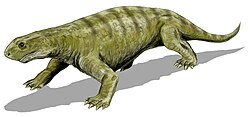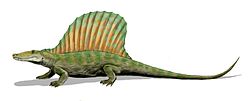| Mastersonia Temporal range: [1] | |
|---|---|
| Scientific classification | |
| Kingdom: | Animalia |
| Phylum: | Chordata |
| Clade: | Synapsida |
| Clade: | Therapsida |
| Suborder: | † Dinocephalia |
| Genus: | † Mastersonia Olson, 1962 |
| Species: | †M. driverensis |
| Binomial name | |
| †Mastersonia driverensis Olson, 1962 | |
Mastersonia is an extinct genus of non-mammalian therapsids from the Lower Permian of San Angelo Formation, Texas. [1] It is only known from a few, very large vertebrae. [2]





